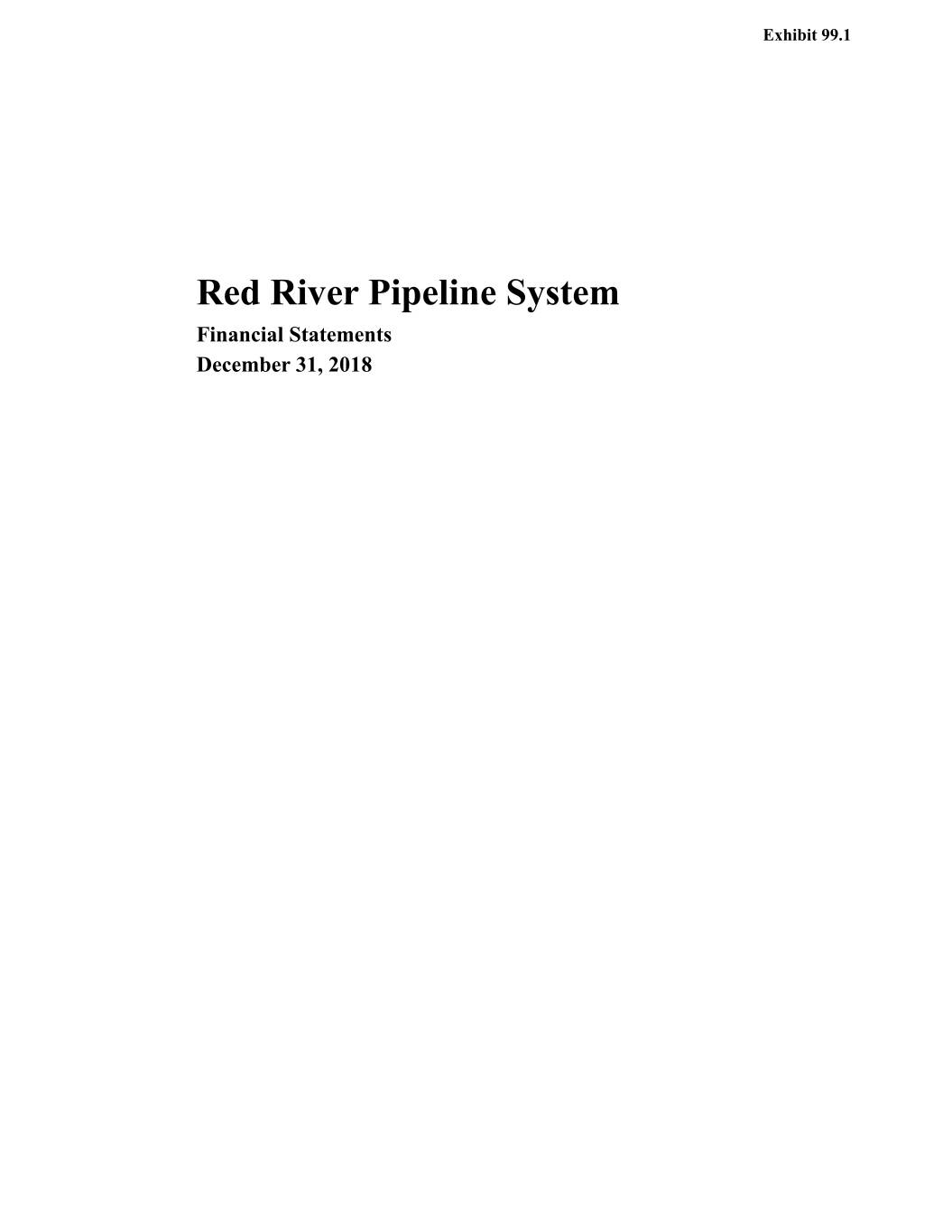
Exhibit 99.1 Red River Pipeline System Financial Statements December 31, 2018
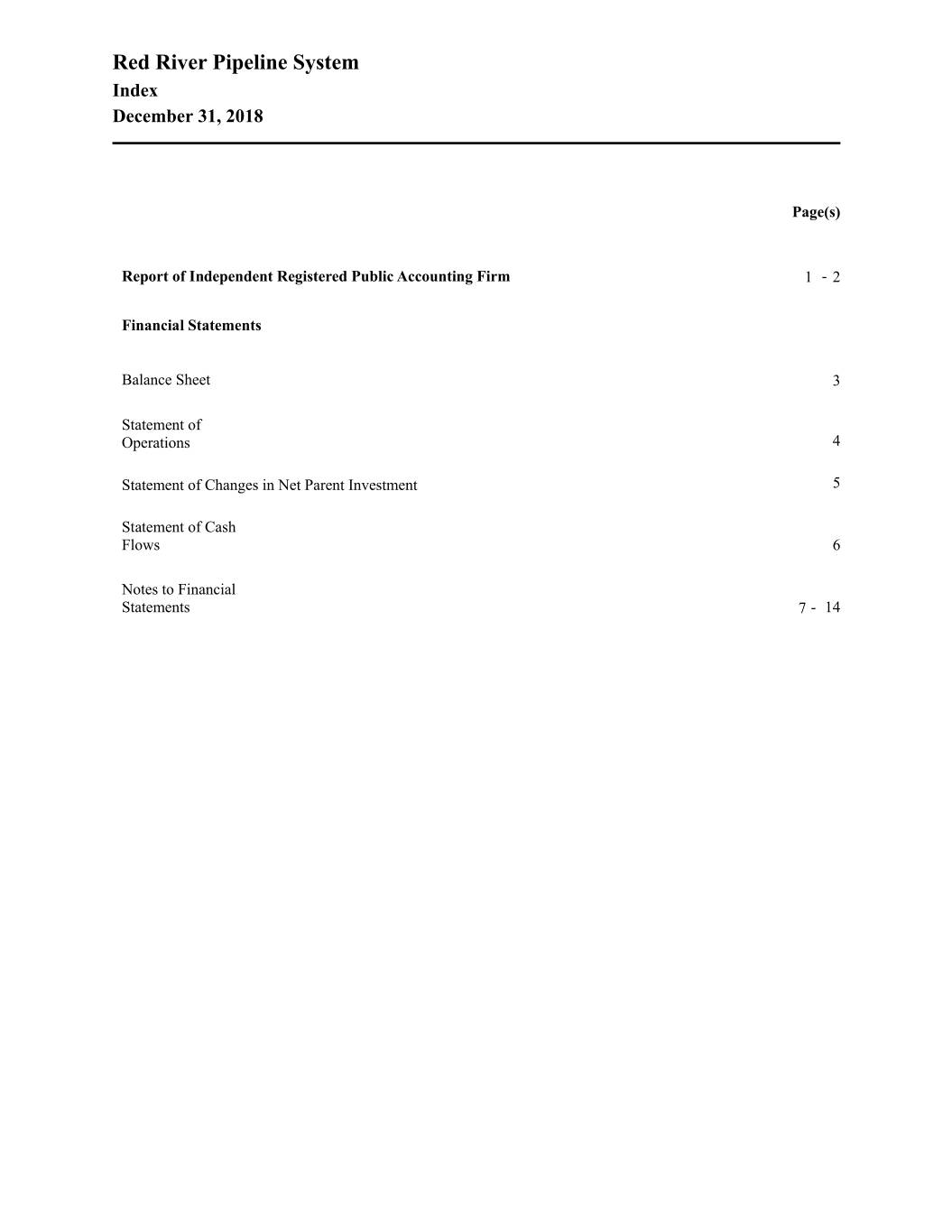
Red River Pipeline System Index December 31, 2018 Page(s) Report of Independent Registered Public Accounting Firm 1 - 2 Financial Statements Balance Sheet 3 Statement of Operations 4 Statement of Changes in Net Parent Investment 5 Statement of Cash Flows 6 Notes to Financial Statements 7 - 14
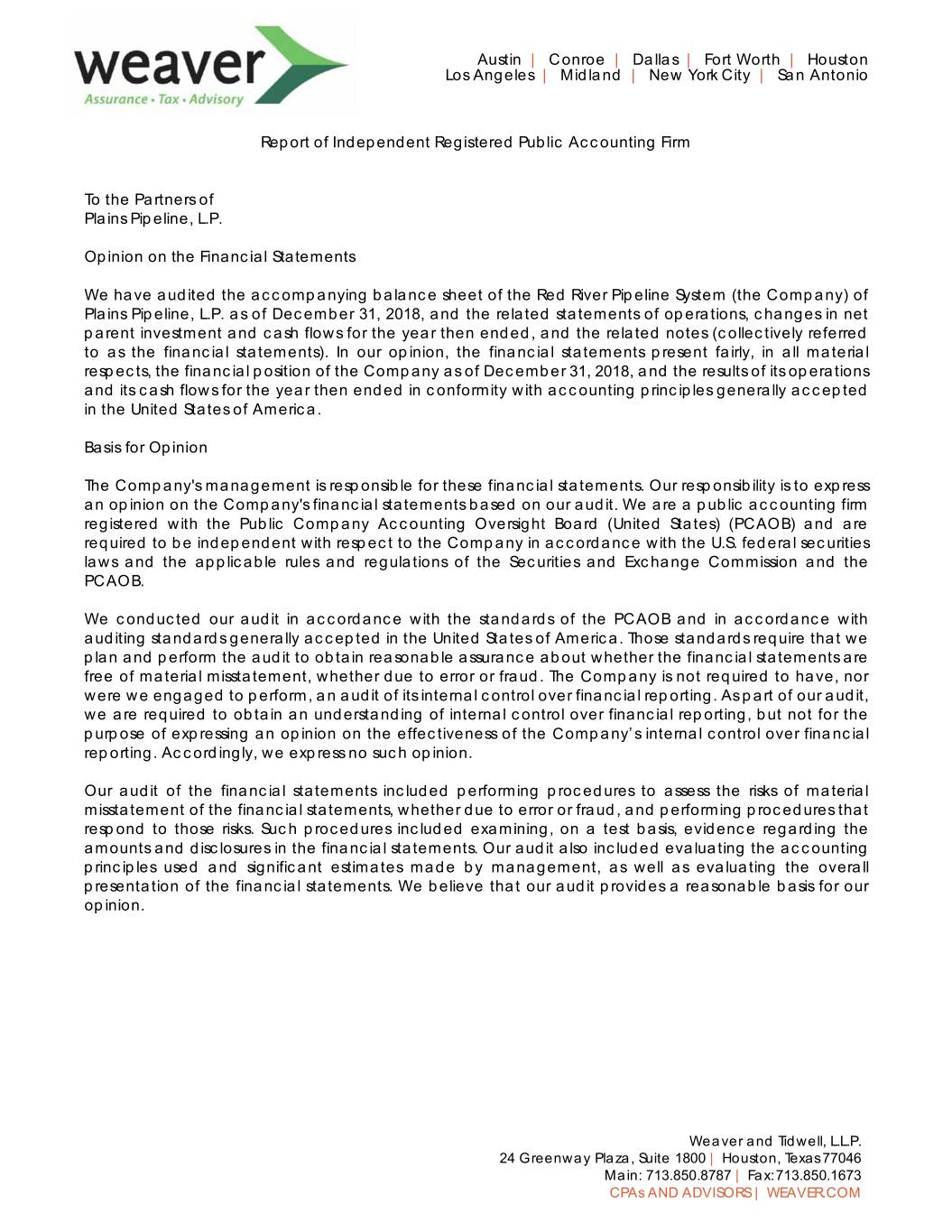
Austin | Conroe | Dallas | Fort Worth | Houston Los Angeles | Midland | New York City | San Antonio Report of Independent Registered Public Accounting Firm To the Partners of Plains Pipeline, L.P. Opinion on the Financial Statements We have audited the accompanying balance sheet of the Red River Pipeline System (the Company) of Plains Pipeline, L.P. as of December 31, 2018, and the related statements of operations, changes in net parent investment and cash flows for the year then ended, and the related notes (collectively referred to as the financial statements). In our opinion, the financial statements present fairly, in all material respects, the financial position of the Company as of December 31, 2018, and the results of its operations and its cash flows for the year then ended in conformity with accounting principles generally accepted in the United States of America. Basis for Opinion The Company's management is responsible for these financial statements. Our responsibility is to express an opinion on the Company's financial statements based on our audit. We are a public accounting firm registered with the Public Company Accounting Oversight Board (United States) (PCAOB) and are required to be independent with respect to the Company in accordance with the U.S. federal securities laws and the applicable rules and regulations of the Securities and Exchange Commission and the PCAOB. We conducted our audit in accordance with the standards of the PCAOB and in accordance with auditing standards generally accepted in the United States of America. Those standards require that we plan and perform the audit to obtain reasonable assurance about whether the financial statements are free of material misstatement, whether due to error or fraud. The Company is not required to have, nor were we engaged to perform, an audit of its internal control over financial reporting. As part of our audit, we are required to obtain an understanding of internal control over financial reporting, but not for the purpose of expressing an opinion on the effectiveness of the Company’s internal control over financial reporting. Accordingly, we express no such opinion. Our audit of the financial statements included performing procedures to assess the risks of material misstatement of the financial statements, whether due to error or fraud, and performing procedures that respond to those risks. Such procedures included examining, on a test basis, evidence regarding the amounts and disclosures in the financial statements. Our audit also included evaluating the accounting principles used and significant estimates made by management, as well as evaluating the overall presentation of the financial statements. We believe that our audit provides a reasonable basis for our opinion. Weaver and Tidwell, L.L.P. 24 Greenway Plaza, Suite 1800 | Houston, Texas 77046 Main: 713.850.8787 | Fax: 713.850.1673 CPAs AND ADVISORS | WEAVER.COM
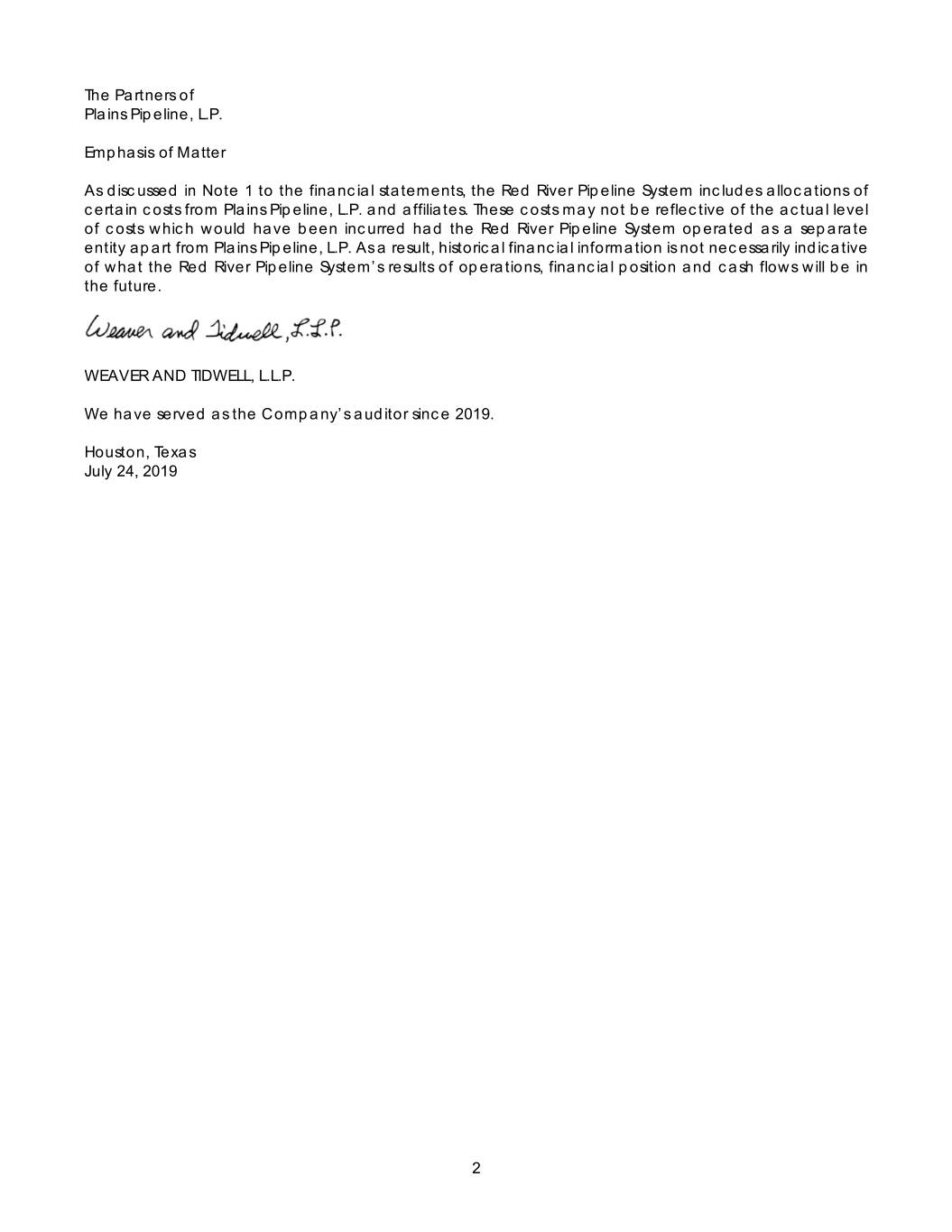
The Partners of Plains Pipeline, L.P. Emphasis of Matter As discussed in Note 1 to the financial statements, the Red River Pipeline System includes allocations of certain costs from Plains Pipeline, L.P. and affiliates. These costs may not be reflective of the actual level of costs which would have been incurred had the Red River Pipeline System operated as a separate entity apart from Plains Pipeline, L.P. As a result, historical financial information is not necessarily indicative of what the Red River Pipeline System’s results of operations, financial position and cash flows will be in the future. WEAVER AND TIDWELL, L.L.P. We have served as the Company’s auditor since 2019. Houston, Texas July 24, 2019 2
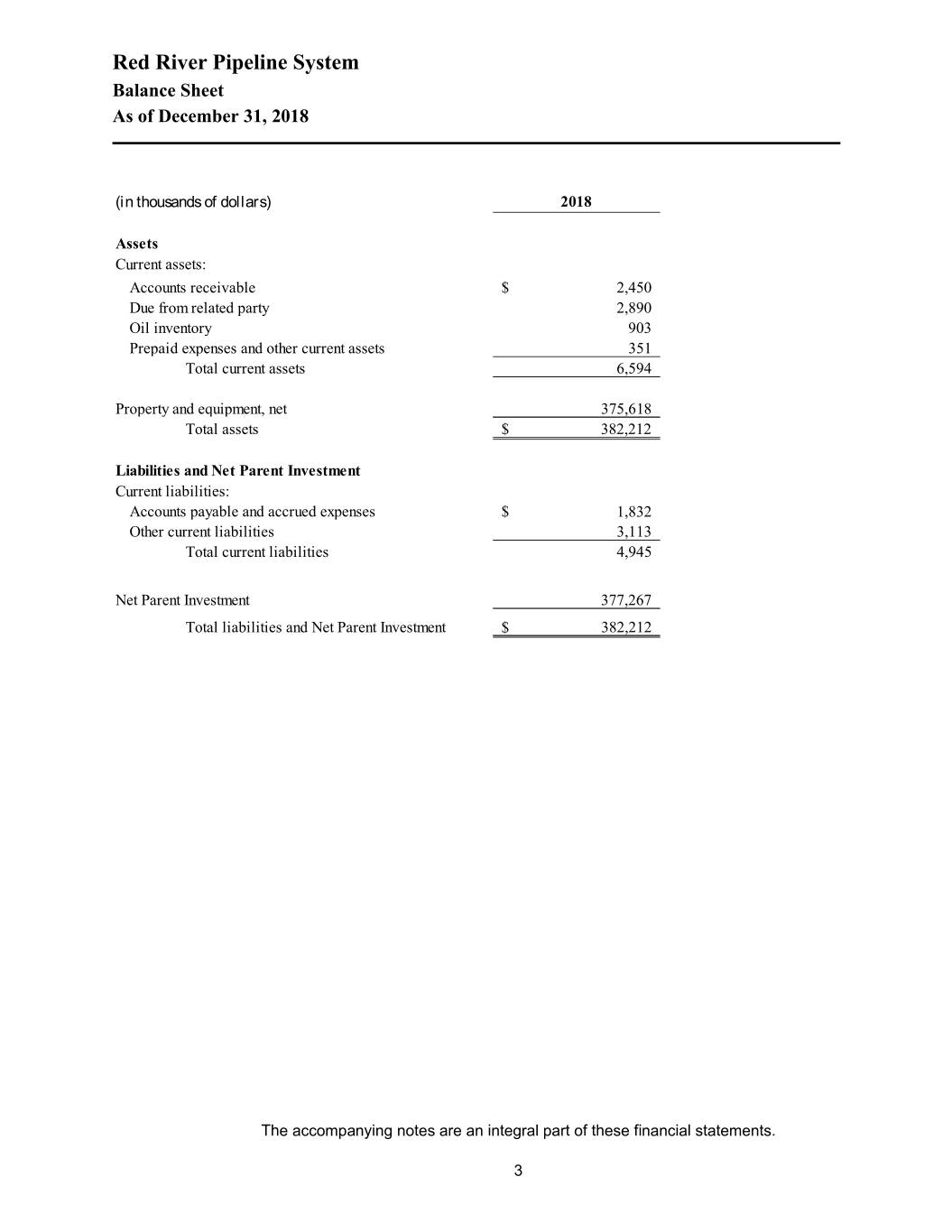
Red River Pipeline System Balance Sheet As of December 31, 2018 (in thousands of dollars) 2018 Assets Current assets: Accounts receivable $ 2,450 Due from related party 2,890 Oil inventory 903 Prepaid expenses and other current assets 351 Total current assets 6,594 Property and equipment, net 375,618 Total assets $ 382,212 Liabilities and Net Parent Investment Current liabilities: Accounts payable and accrued expenses $ 1,832 Other current liabilities 3,113 Total current liabilities 4,945 Net Parent Investment 377,267 Total liabilities and Net Parent Investment$ 382,212 The accompanying notes are an integral part of these financial statements. 3
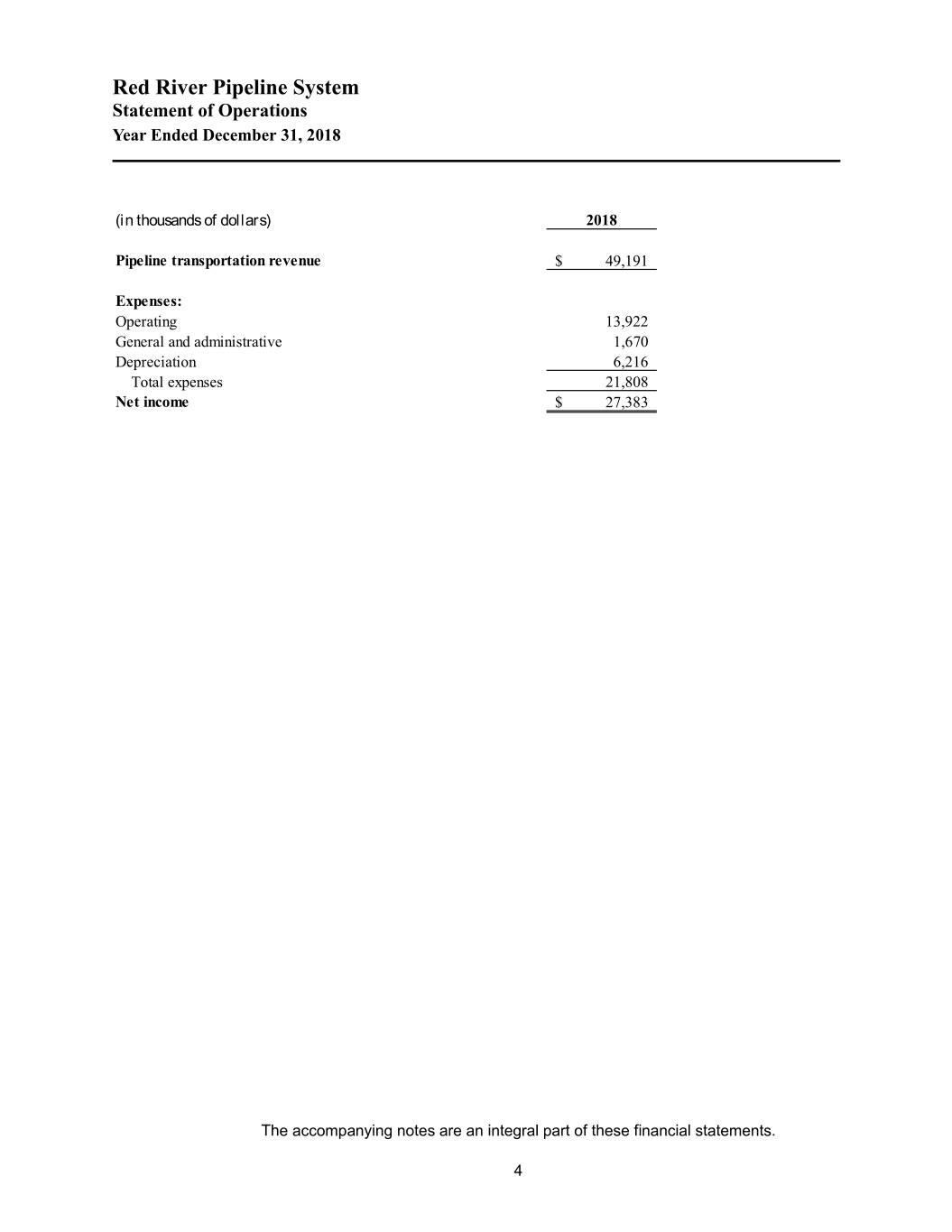
Red River Pipeline System Statement of Operations Year Ended December 31, 2018 (in thousands of dollars) 2018 Pipeline transportation revenue $ 49,191 Expenses: Operating 13,922 General and administrative 1,670 Depreciation 6,216 Total expenses 21,808 Net income $ 27,383 The accompanying notes are an integral part of these financial statements. 4
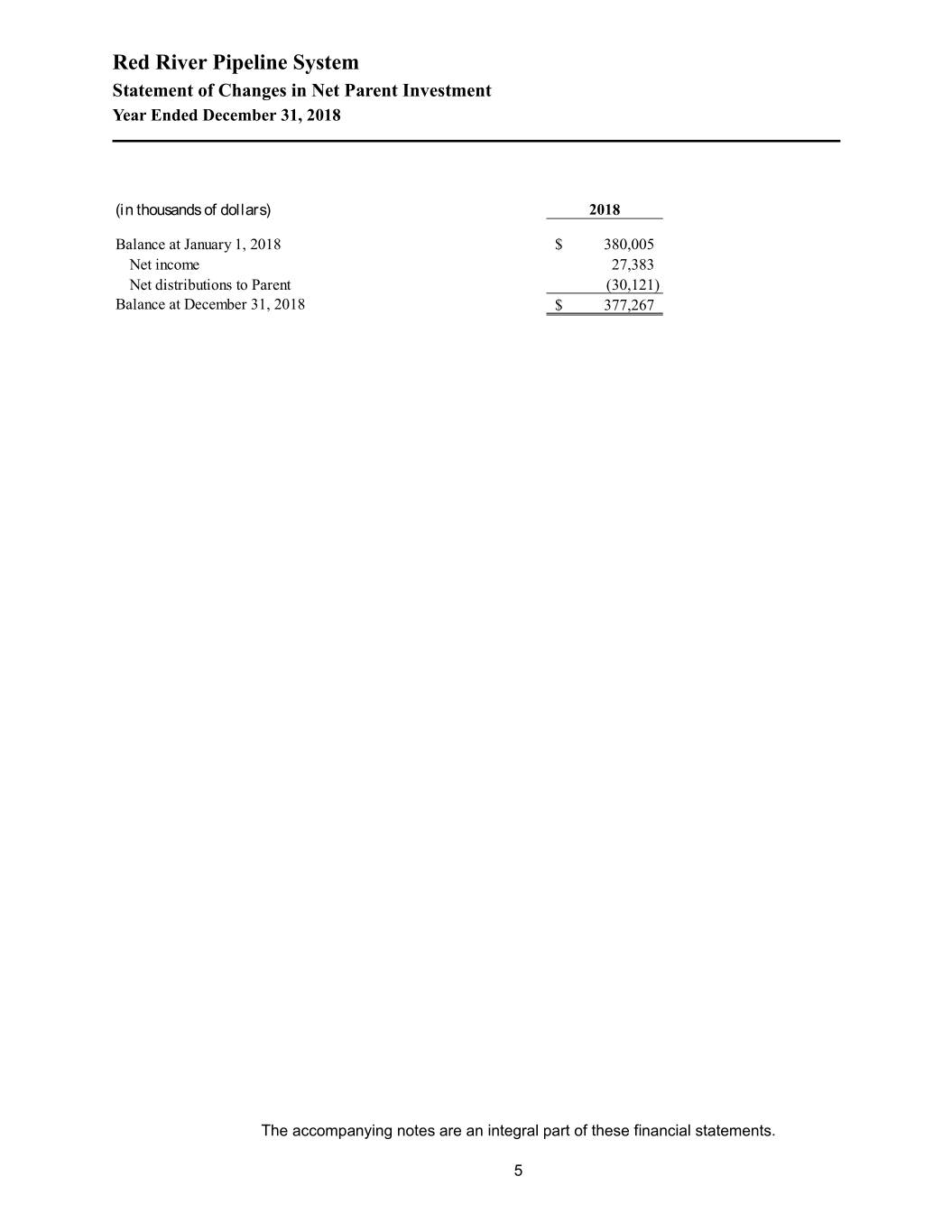
Red River Pipeline System Statement of Changes in Net Parent Investment Year Ended December 31, 2018 (in thousands of dollars) 2018 Balance at January 1, 2018$ 380,005 Net income 27,383 Net distributions to Parent (30,121) Balance at December 31, 2018 $ 377,267 The accompanying notes are an integral part of these financial statements. 5
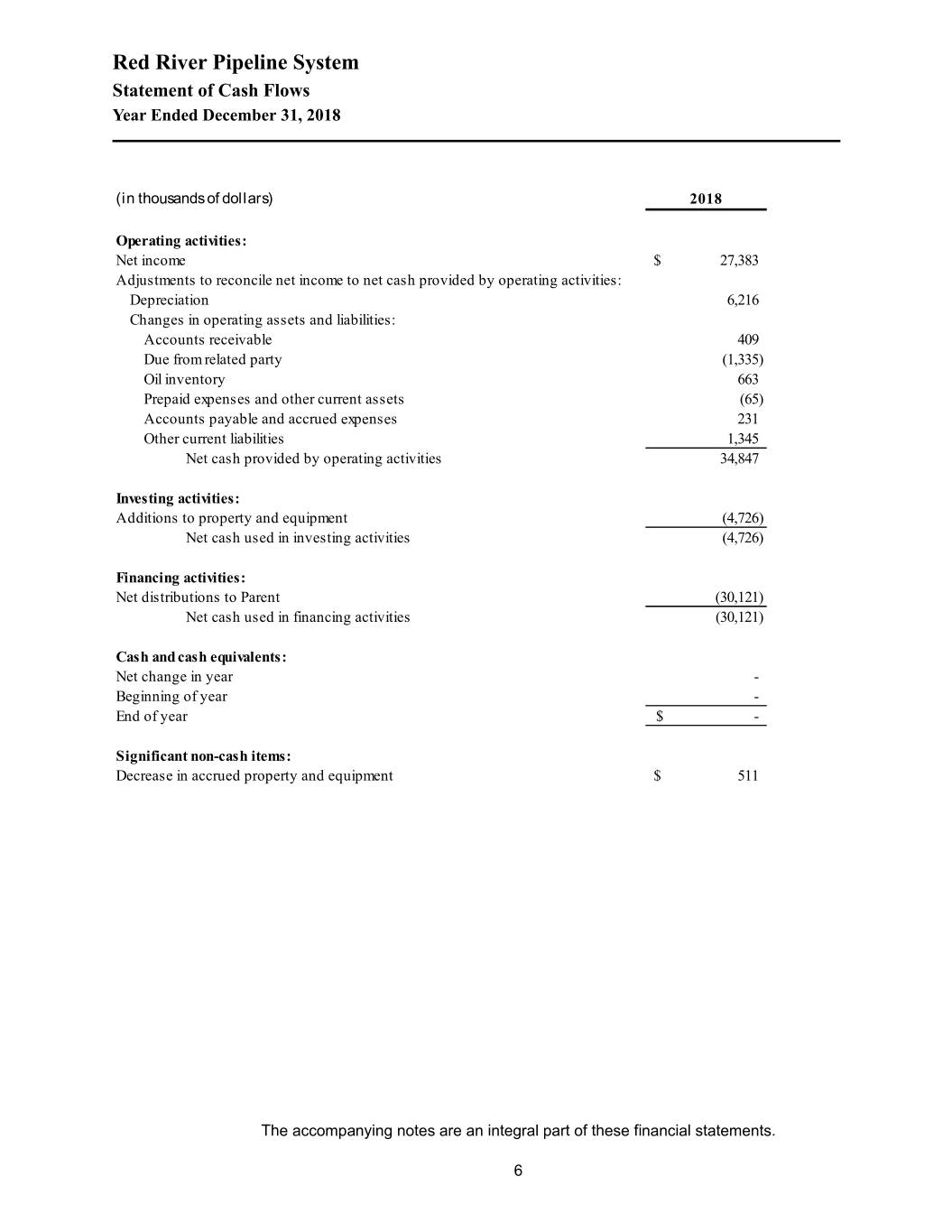
Red River Pipeline System Statement of Cash Flows Year Ended December 31, 2018 (in thousands of dollars) 2018 Operating activities: Net income $ 27,383 Adjustments to reconcile net income to net cash provided by operating activities: Depreciation 6,216 Changes in operating assets and liabilities: Accounts receivable 409 Due from related party (1,335) Oil inventory 663 Prepaid expenses and other current assets (65) Accounts payable and accrued expenses 231 Other current liabilities 1,345 Net cash provided by operating activities 34,847 Investing activities: Additions to property and equipment (4,726) Net cash used in investing activities (4,726) Financing activities: Net distributions to Parent (30,121) Net cash used in financing activities (30,121) Cash and cash equivalents: Net change in year - Beginning of year - End of year $ - Significant non-cash items: Decrease in accrued property and equipment$ 511 The accompanying notes are an integral part of these financial statements. 6
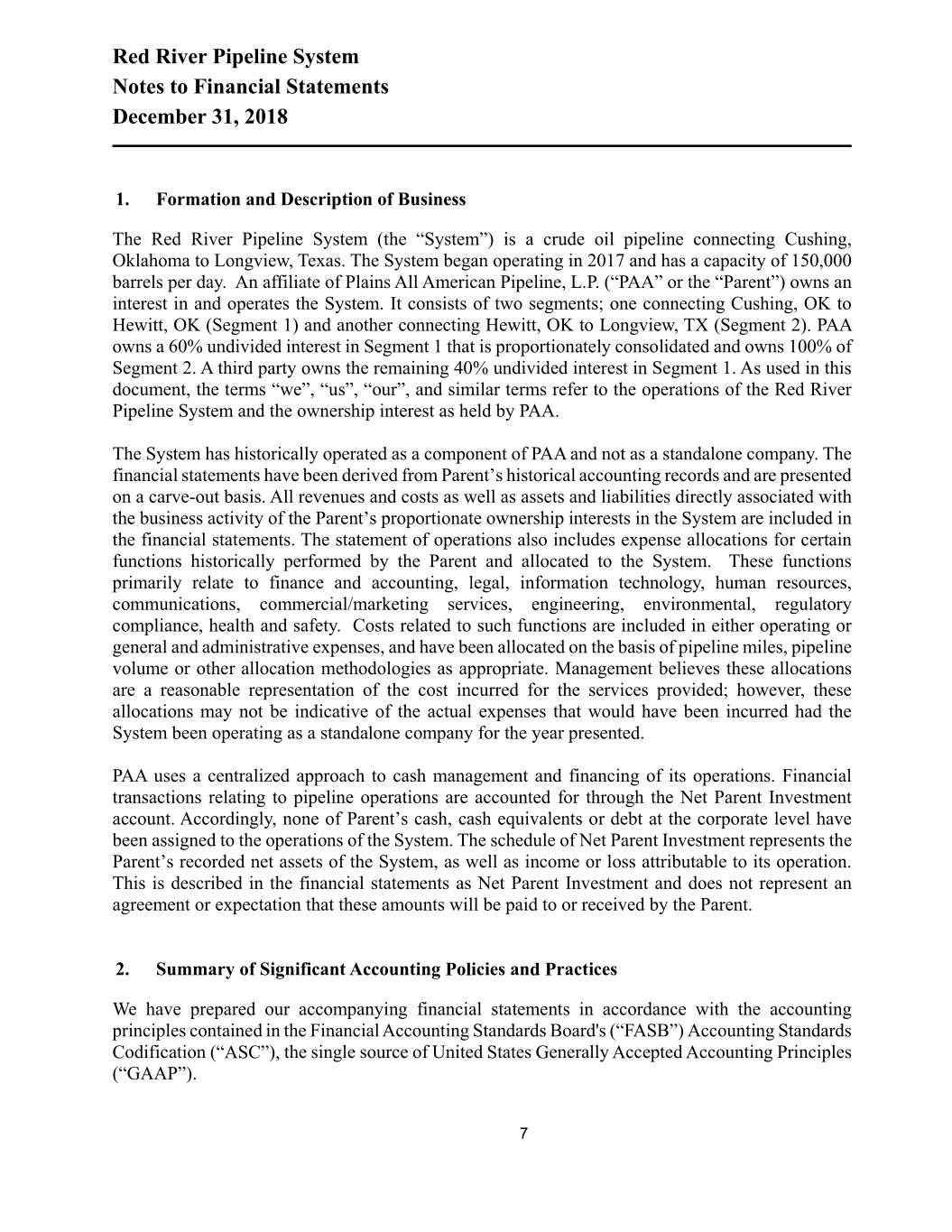
Red River Pipeline System Notes to Financial Statements December 31, 2018 1. Formation and Description of Business The Red River Pipeline System (the “System”) is a crude oil pipeline connecting Cushing, Oklahoma to Longview, Texas. The System began operating in 2017 and has a capacity of 150,000 barrels per day. An affiliate of Plains All American Pipeline, L.P. (“PAA” or the “Parent”) owns an interest in and operates the System. It consists of two segments; one connecting Cushing, OK to Hewitt, OK (Segment 1) and another connecting Hewitt, OK to Longview, TX (Segment 2). PAA owns a 60% undivided interest in Segment 1 that is proportionately consolidated and owns 100% of Segment 2. A third party owns the remaining 40% undivided interest in Segment 1. As used in this document, the terms “we”, “us”, “our”, and similar terms refer to the operations of the Red River Pipeline System and the ownership interest as held by PAA. The System has historically operated as a component of PAA and not as a standalone company. The financial statements have been derived from Parent’s historical accounting records and are presented on a carve-out basis. All revenues and costs as well as assets and liabilities directly associated with the business activity of the Parent’s proportionate ownership interests in the System are included in the financial statements. The statement of operations also includes expense allocations for certain functions historically performed by the Parent and allocated to the System. These functions primarily relate to finance and accounting, legal, information technology, human resources, communications, commercial/marketing services, engineering, environmental, regulatory compliance, health and safety. Costs related to such functions are included in either operating or general and administrative expenses, and have been allocated on the basis of pipeline miles, pipeline volume or other allocation methodologies as appropriate. Management believes these allocations are a reasonable representation of the cost incurred for the services provided; however, these allocations may not be indicative of the actual expenses that would have been incurred had the System been operating as a standalone company for the year presented. PAA uses a centralized approach to cash management and financing of its operations. Financial transactions relating to pipeline operations are accounted for through the Net Parent Investment account. Accordingly, none of Parent’s cash, cash equivalents or debt at the corporate level have been assigned to the operations of the System. The schedule of Net Parent Investment represents the Parent’s recorded net assets of the System, as well as income or loss attributable to its operation. This is described in the financial statements as Net Parent Investment and does not represent an agreement or expectation that these amounts will be paid to or received by the Parent. 2. Summary of Significant Accounting Policies and Practices We have prepared our accompanying financial statements in accordance with the accounting principles contained in the Financial Accounting Standards Board's (“FASB”) Accounting Standards Codification (“ASC”), the single source of United States Generally Accepted Accounting Principles (“GAAP”). 7
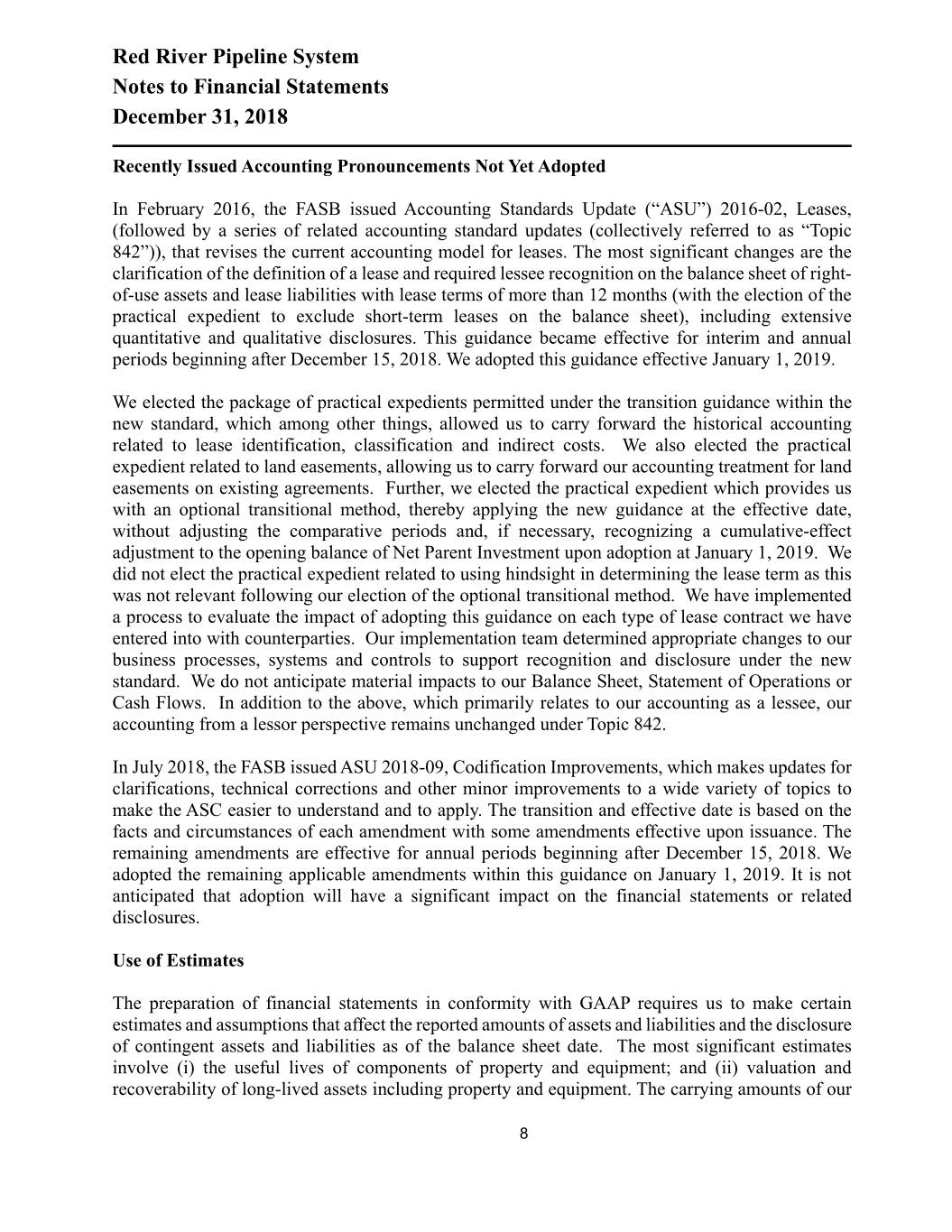
Red River Pipeline System Notes to Financial Statements December 31, 2018 Recently Issued Accounting Pronouncements Not Yet Adopted In February 2016, the FASB issued Accounting Standards Update (“ASU”) 2016-02, Leases, (followed by a series of related accounting standard updates (collectively referred to as “Topic 842”)), that revises the current accounting model for leases. The most significant changes are the clarification of the definition of a lease and required lessee recognition on the balance sheet of right- of-use assets and lease liabilities with lease terms of more than 12 months (with the election of the practical expedient to exclude short-term leases on the balance sheet), including extensive quantitative and qualitative disclosures. This guidance became effective for interim and annual periods beginning after December 15, 2018. We adopted this guidance effective January 1, 2019. We elected the package of practical expedients permitted under the transition guidance within the new standard, which among other things, allowed us to carry forward the historical accounting related to lease identification, classification and indirect costs. We also elected the practical expedient related to land easements, allowing us to carry forward our accounting treatment for land easements on existing agreements. Further, we elected the practical expedient which provides us with an optional transitional method, thereby applying the new guidance at the effective date, without adjusting the comparative periods and, if necessary, recognizing a cumulative-effect adjustment to the opening balance of Net Parent Investment upon adoption at January 1, 2019. We did not elect the practical expedient related to using hindsight in determining the lease term as this was not relevant following our election of the optional transitional method. We have implemented a process to evaluate the impact of adopting this guidance on each type of lease contract we have entered into with counterparties. Our implementation team determined appropriate changes to our business processes, systems and controls to support recognition and disclosure under the new standard. We do not anticipate material impacts to our Balance Sheet, Statement of Operations or Cash Flows. In addition to the above, which primarily relates to our accounting as a lessee, our accounting from a lessor perspective remains unchanged under Topic 842. In July 2018, the FASB issued ASU 2018-09, Codification Improvements, which makes updates for clarifications, technical corrections and other minor improvements to a wide variety of topics to make the ASC easier to understand and to apply. The transition and effective date is based on the facts and circumstances of each amendment with some amendments effective upon issuance. The remaining amendments are effective for annual periods beginning after December 15, 2018. We adopted the remaining applicable amendments within this guidance on January 1, 2019. It is not anticipated that adoption will have a significant impact on the financial statements or related disclosures. Use of Estimates The preparation of financial statements in conformity with GAAP requires us to make certain estimates and assumptions that affect the reported amounts of assets and liabilities and the disclosure of contingent assets and liabilities as of the balance sheet date. The most significant estimates involve (i) the useful lives of components of property and equipment; and (ii) valuation and recoverability of long-lived assets including property and equipment. The carrying amounts of our 8
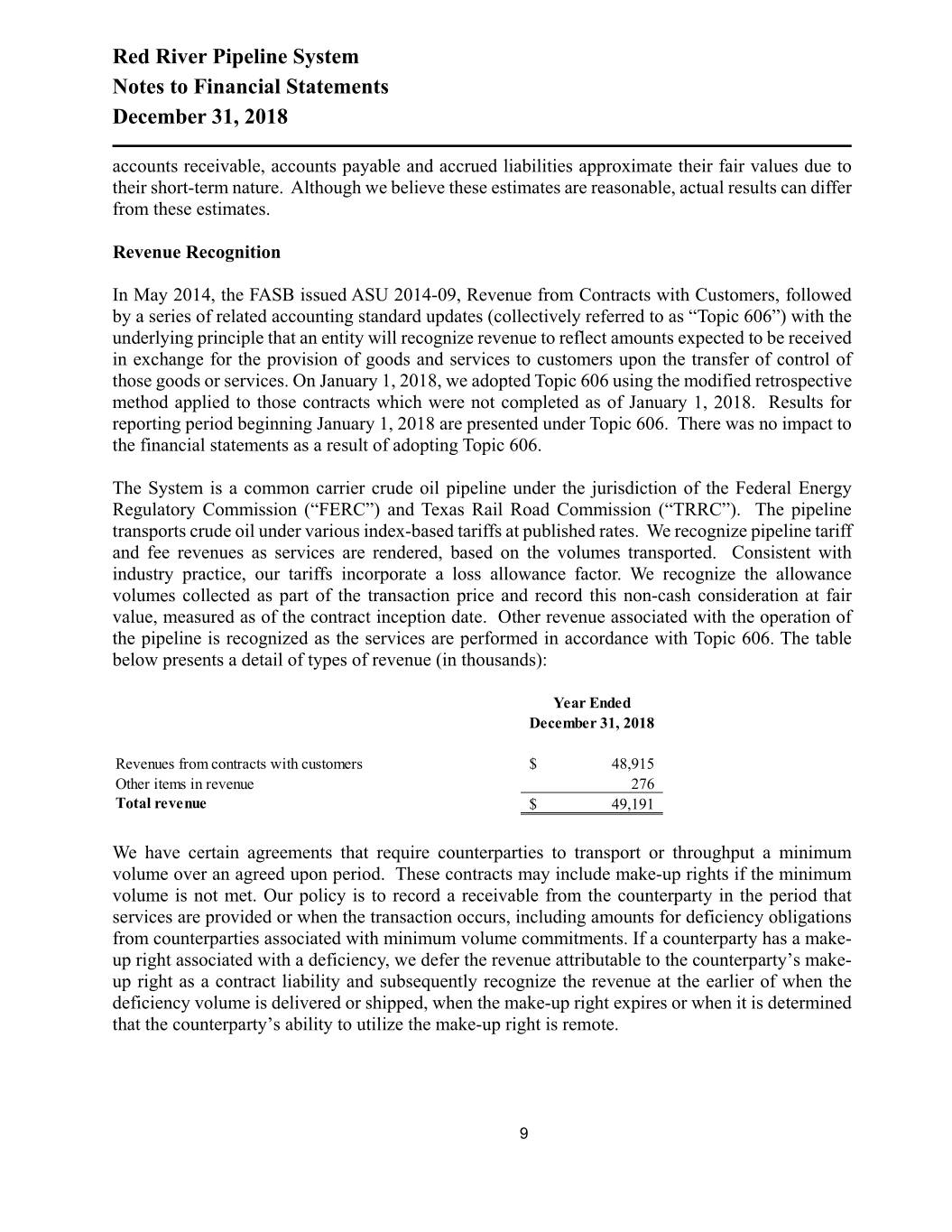
Red River Pipeline System Notes to Financial Statements December 31, 2018 accounts receivable, accounts payable and accrued liabilities approximate their fair values due to their short-term nature. Although we believe these estimates are reasonable, actual results can differ from these estimates. Revenue Recognition In May 2014, the FASB issued ASU 2014-09, Revenue from Contracts with Customers, followed by a series of related accounting standard updates (collectively referred to as “Topic 606”) with the underlying principle that an entity will recognize revenue to reflect amounts expected to be received in exchange for the provision of goods and services to customers upon the transfer of control of those goods or services. On January 1, 2018, we adopted Topic 606 using the modified retrospective method applied to those contracts which were not completed as of January 1, 2018. Results for reporting period beginning January 1, 2018 are presented under Topic 606. There was no impact to the financial statements as a result of adopting Topic 606. The System is a common carrier crude oil pipeline under the jurisdiction of the Federal Energy Regulatory Commission (“FERC”) and Texas Rail Road Commission (“TRRC”). The pipeline transports crude oil under various index-based tariffs at published rates. We recognize pipeline tariff and fee revenues as services are rendered, based on the volumes transported. Consistent with industry practice, our tariffs incorporate a loss allowance factor. We recognize the allowance volumes collected as part of the transaction price and record this non-cash consideration at fair value, measured as of the contract inception date. Other revenue associated with the operation of the pipeline is recognized as the services are performed in accordance with Topic 606. The table below presents a detail of types of revenue (in thousands): Year Ended December 31, 2018 Revenues from contracts with customers$ 48,915 Other items in revenue 276 Total revenue $ 49,191 We have certain agreements that require counterparties to transport or throughput a minimum volume over an agreed upon period. These contracts may include make-up rights if the minimum volume is not met. Our policy is to record a receivable from the counterparty in the period that services are provided or when the transaction occurs, including amounts for deficiency obligations from counterparties associated with minimum volume commitments. If a counterparty has a make- up right associated with a deficiency, we defer the revenue attributable to the counterparty’s make- up right as a contract liability and subsequently recognize the revenue at the earlier of when the deficiency volume is delivered or shipped, when the make-up right expires or when it is determined that the counterparty’s ability to utilize the make-up right is remote. 9

Red River Pipeline System Notes to Financial Statements December 31, 2018 The following table illustrates the change in the liability associated with agreements that include minimum volume commitments during the year ended December 31, 2018 (in thousands): Contract Liabilities Balance at January 1, 2018$ 755 Recorded as revenue in the current period (755) Additions during the current period 1,502 Balance at December 31, 2018 $ 1,502 Topic 606 requires presentation of information about partially and wholly unsatisfied performance obligations under contracts that exist as of the end of the period. The information includes the amount of consideration allocated to and the timing of revenue recognition of those remaining performance obligations. Certain contracts meet the requirements for the presentation as remaining performance obligations. These arrangements include a fixed minimum level of service, typically a set volume of service, and do not contain any variability other than expected timing within a limited range. The following table presents the amount of consideration (based on current applicable tariff rates) associated with remaining performance obligations as of December 31, 2018 (in thousands): 2024 and 2019 2020 2021 2022 2023 Thereafter Revenue supported by minimum volume commitments $ 24,057 $ 24,123 $ 24,057 $ 24,057 $ 24,057 $ 74,279 Accounts Receivable All amounts within accounts receivable and due from related parties consist of amounts receivable related to pipeline transportation revenues from contracts with customers. We invoice customers in the month following that in which services were provided and require payment within 30 days of the invoice date. We review all outstanding receivable balances on a monthly basis and record an allowance for amounts that we expect will not be fully recovered. We do not apply actual balances against any allowance until we have exhausted substantially all collection efforts. There is no allowance for doubtful accounts as of December 31, 2018. Oil Inventories Oil inventory consists of crude oil in pipelines and storage facilities and is valued at the lower of cost or net realizable value, with cost determined using an average cost method. At the end of each reporting period, we assess the carrying value of our inventory and make any adjustments necessary to reduce the carrying value to the applicable net realizable value. There were no adjustments to net realizable value made in 2018. 10
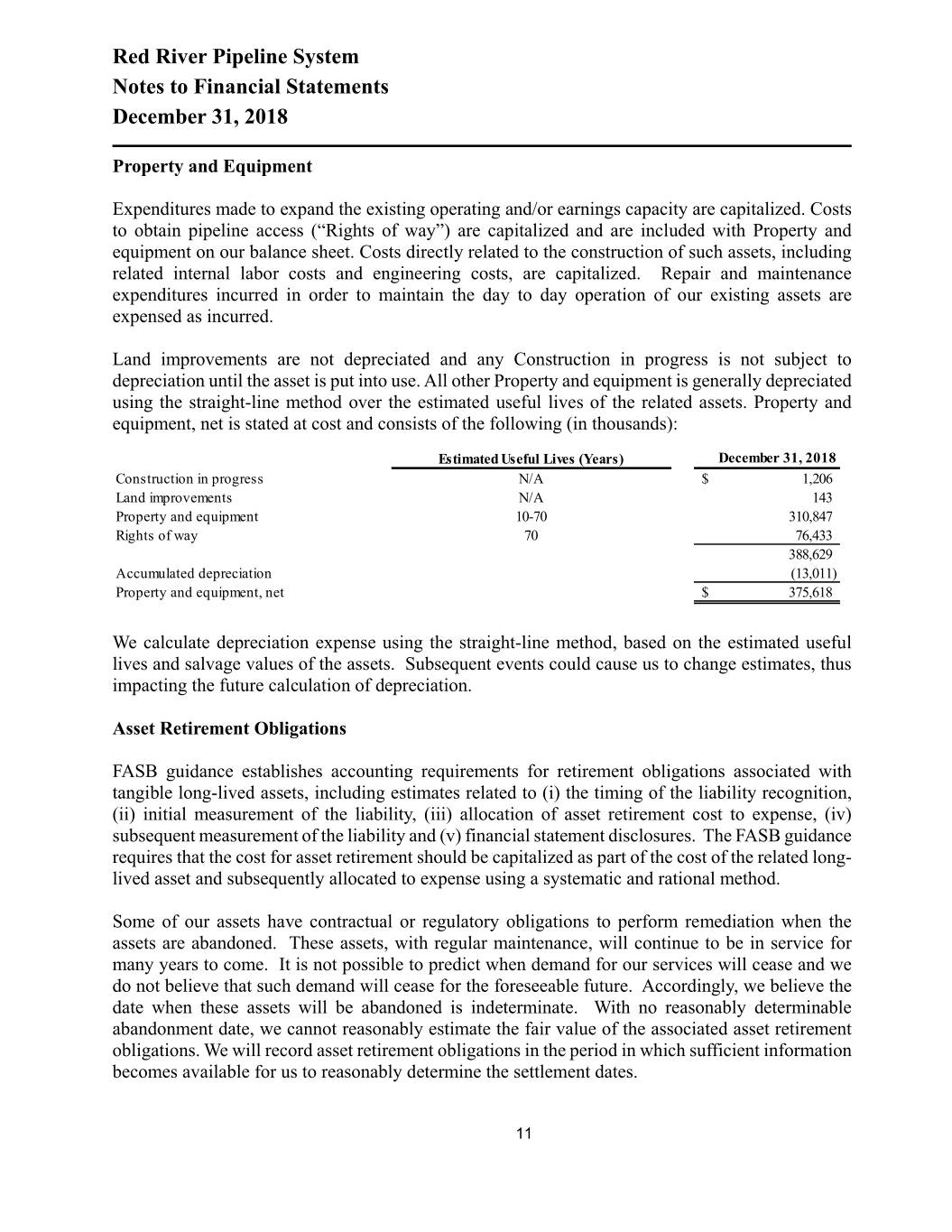
Red River Pipeline System Notes to Financial Statements December 31, 2018 Property and Equipment Expenditures made to expand the existing operating and/or earnings capacity are capitalized. Costs to obtain pipeline access (“Rights of way”) are capitalized and are included with Property and equipment on our balance sheet. Costs directly related to the construction of such assets, including related internal labor costs and engineering costs, are capitalized. Repair and maintenance expenditures incurred in order to maintain the day to day operation of our existing assets are expensed as incurred. Land improvements are not depreciated and any Construction in progress is not subject to depreciation until the asset is put into use. All other Property and equipment is generally depreciated using the straight-line method over the estimated useful lives of the related assets. Property and equipment, net is stated at cost and consists of the following (in thousands): Estimated Useful Lives (Years) December 31, 2018 Construction in progress N/A$ 1,206 Land improvements N/A 143 Property and equipment 10-70 310,847 Rights of way 70 76,433 388,629 Accumulated depreciation (13,011) Property and equipment, net $ 375,618 We calculate depreciation expense using the straight-line method, based on the estimated useful lives and salvage values of the assets. Subsequent events could cause us to change estimates, thus impacting the future calculation of depreciation. Asset Retirement Obligations FASB guidance establishes accounting requirements for retirement obligations associated with tangible long-lived assets, including estimates related to (i) the timing of the liability recognition, (ii) initial measurement of the liability, (iii) allocation of asset retirement cost to expense, (iv) subsequent measurement of the liability and (v) financial statement disclosures. The FASB guidance requires that the cost for asset retirement should be capitalized as part of the cost of the related long- lived asset and subsequently allocated to expense using a systematic and rational method. Some of our assets have contractual or regulatory obligations to perform remediation when the assets are abandoned. These assets, with regular maintenance, will continue to be in service for many years to come. It is not possible to predict when demand for our services will cease and we do not believe that such demand will cease for the foreseeable future. Accordingly, we believe the date when these assets will be abandoned is indeterminate. With no reasonably determinable abandonment date, we cannot reasonably estimate the fair value of the associated asset retirement obligations. We will record asset retirement obligations in the period in which sufficient information becomes available for us to reasonably determine the settlement dates. 11
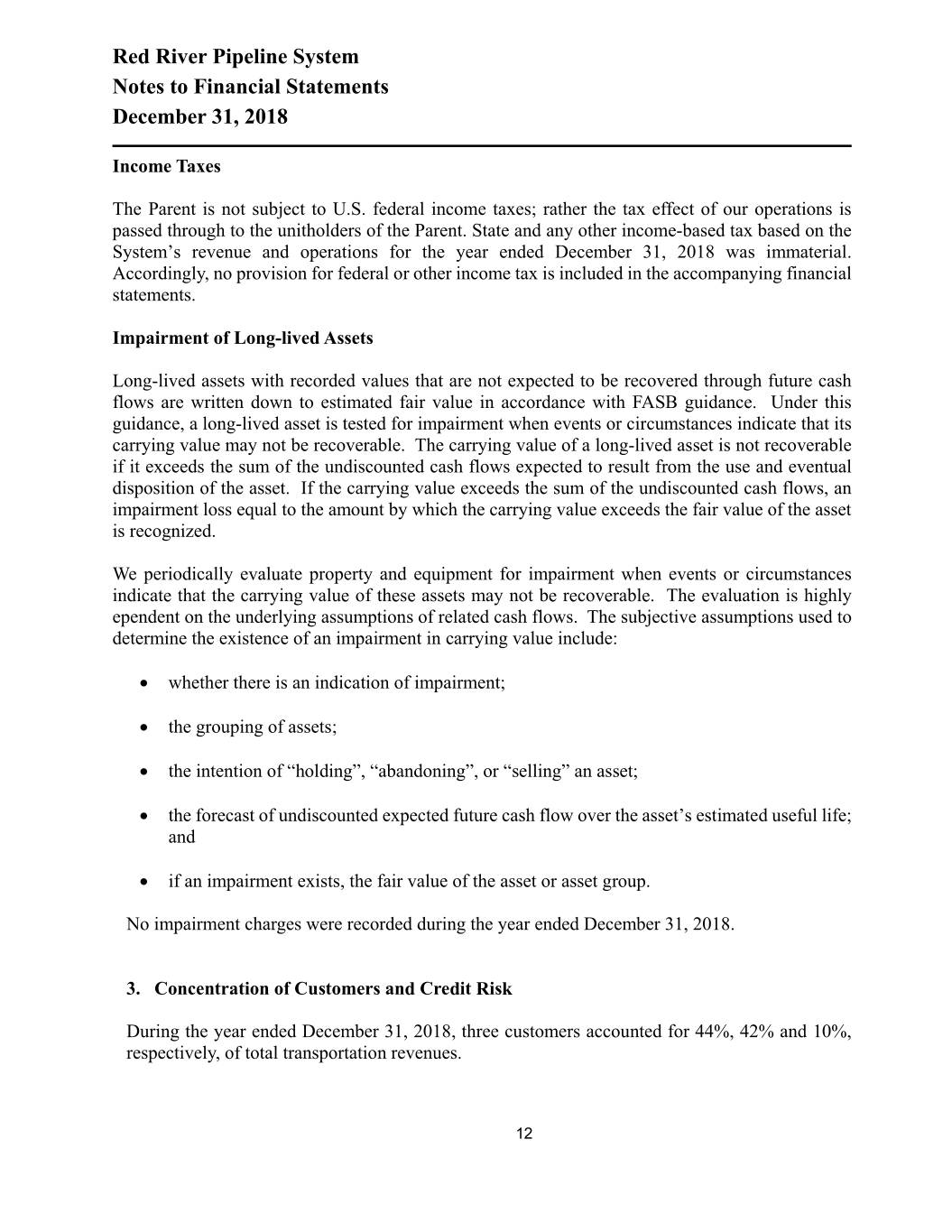
Red River Pipeline System Notes to Financial Statements December 31, 2018 Income Taxes The Parent is not subject to U.S. federal income taxes; rather the tax effect of our operations is passed through to the unitholders of the Parent. State and any other income-based tax based on the System’s revenue and operations for the year ended December 31, 2018 was immaterial. Accordingly, no provision for federal or other income tax is included in the accompanying financial statements. Impairment of Long-lived Assets Long-lived assets with recorded values that are not expected to be recovered through future cash flows are written down to estimated fair value in accordance with FASB guidance. Under this guidance, a long-lived asset is tested for impairment when events or circumstances indicate that its carrying value may not be recoverable. The carrying value of a long-lived asset is not recoverable if it exceeds the sum of the undiscounted cash flows expected to result from the use and eventual disposition of the asset. If the carrying value exceeds the sum of the undiscounted cash flows, an impairment loss equal to the amount by which the carrying value exceeds the fair value of the asset is recognized. We periodically evaluate property and equipment for impairment when events or circumstances indicate that the carrying value of these assets may not be recoverable. The evaluation is highly ependent on the underlying assumptions of related cash flows. The subjective assumptions used to determine the existence of an impairment in carrying value include: whether there is an indication of impairment; the grouping of assets; the intention of “holding”, “abandoning”, or “selling” an asset; the forecast of undiscounted expected future cash flow over the asset’s estimated useful life; and if an impairment exists, the fair value of the asset or asset group. No impairment charges were recorded during the year ended December 31, 2018. 3. Concentration of Customers and Credit Risk During the year ended December 31, 2018, three customers accounted for 44%, 42% and 10%, respectively, of total transportation revenues. 12
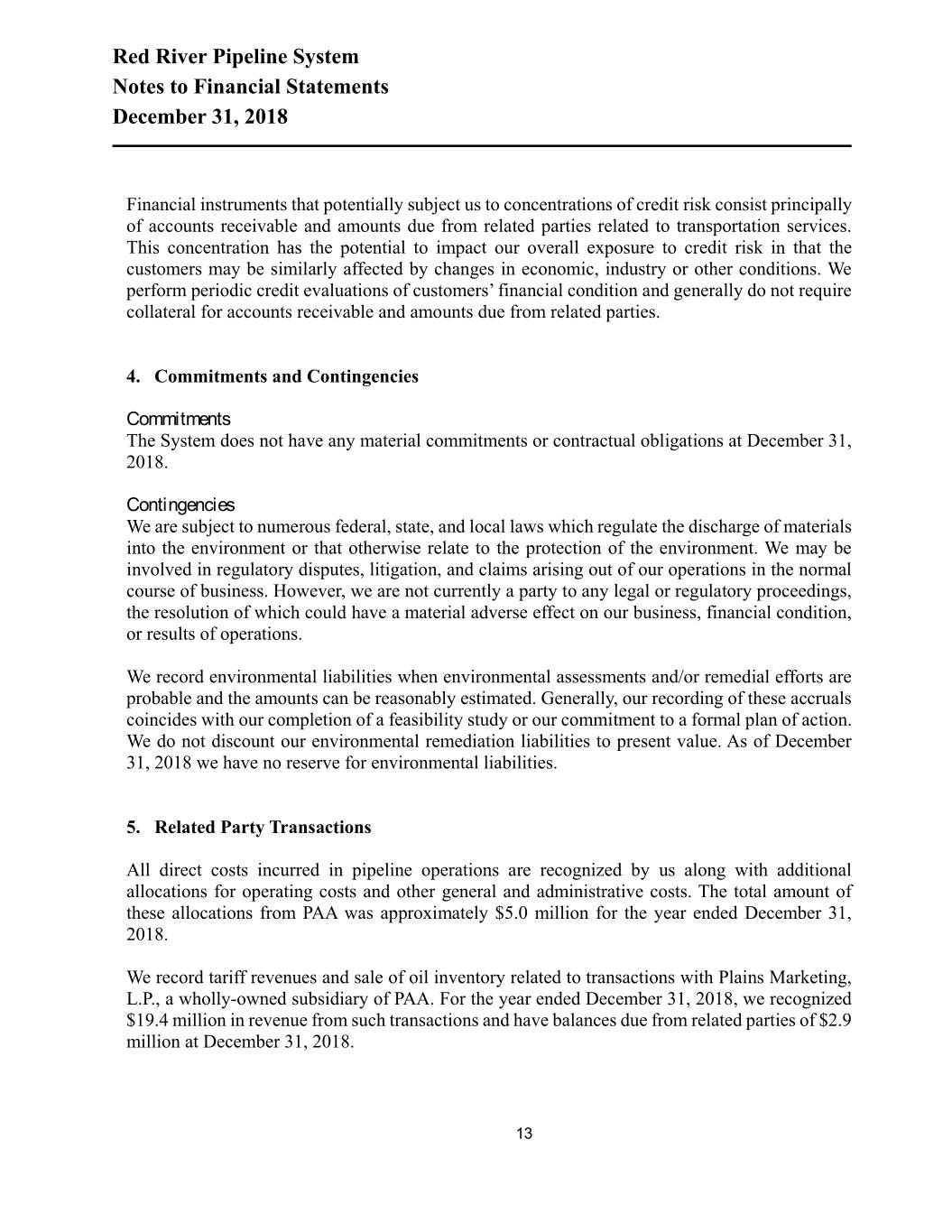
Red River Pipeline System Notes to Financial Statements December 31, 2018 Financial instruments that potentially subject us to concentrations of credit risk consist principally of accounts receivable and amounts due from related parties related to transportation services. This concentration has the potential to impact our overall exposure to credit risk in that the customers may be similarly affected by changes in economic, industry or other conditions. We perform periodic credit evaluations of customers’ financial condition and generally do not require collateral for accounts receivable and amounts due from related parties. 4. Commitments and Contingencies Commitments The System does not have any material commitments or contractual obligations at December 31, 2018. Contingencies We are subject to numerous federal, state, and local laws which regulate the discharge of materials into the environment or that otherwise relate to the protection of the environment. We may be involved in regulatory disputes, litigation, and claims arising out of our operations in the normal course of business. However, we are not currently a party to any legal or regulatory proceedings, the resolution of which could have a material adverse effect on our business, financial condition, or results of operations. We record environmental liabilities when environmental assessments and/or remedial efforts are probable and the amounts can be reasonably estimated. Generally, our recording of these accruals coincides with our completion of a feasibility study or our commitment to a formal plan of action. We do not discount our environmental remediation liabilities to present value. As of December 31, 2018 we have no reserve for environmental liabilities. 5. Related Party Transactions All direct costs incurred in pipeline operations are recognized by us along with additional allocations for operating costs and other general and administrative costs. The total amount of these allocations from PAA was approximately $5.0 million for the year ended December 31, 2018. We record tariff revenues and sale of oil inventory related to transactions with Plains Marketing, L.P., a wholly-owned subsidiary of PAA. For the year ended December 31, 2018, we recognized $19.4 million in revenue from such transactions and have balances due from related parties of $2.9 million at December 31, 2018. 13
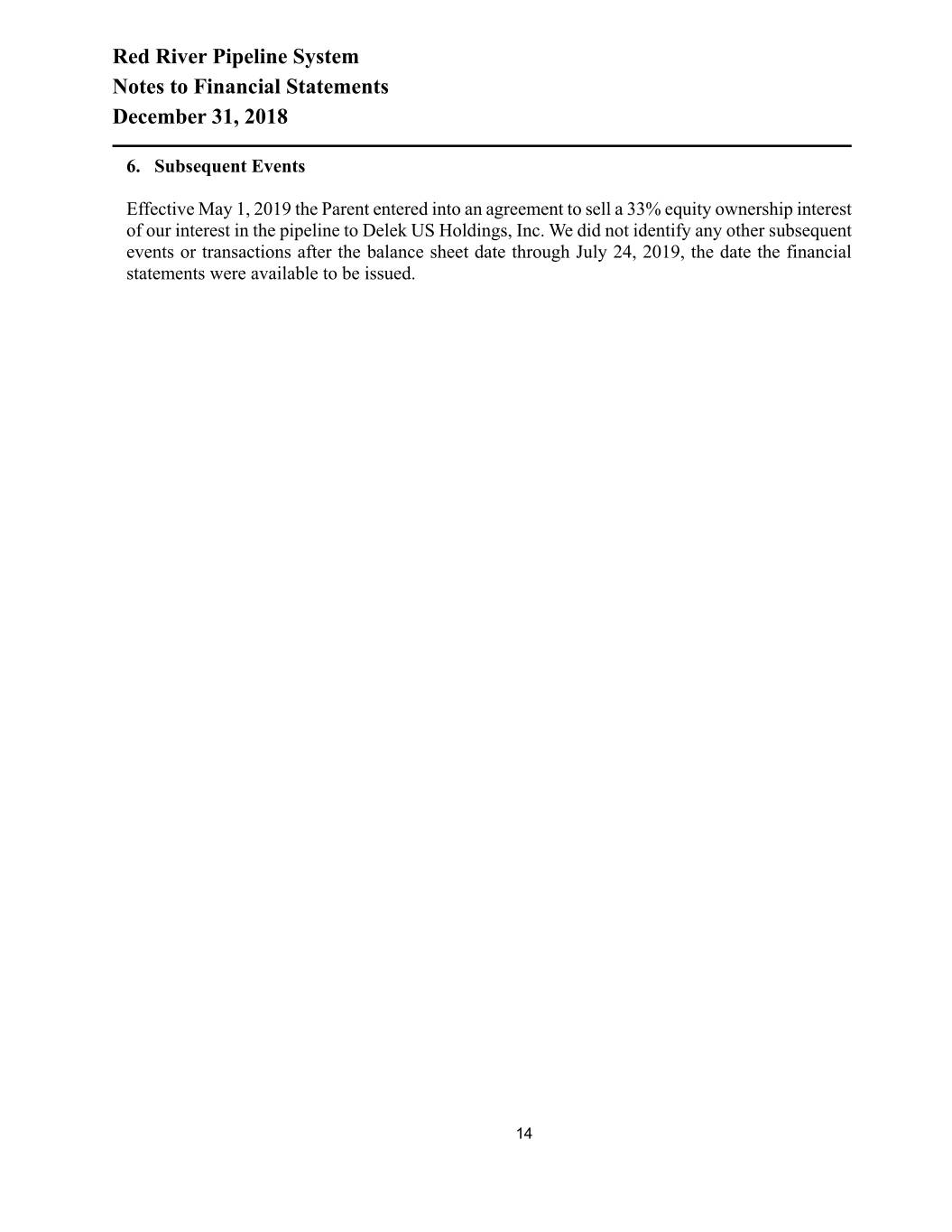
Red River Pipeline System Notes to Financial Statements December 31, 2018 6. Subsequent Events Effective May 1, 2019 the Parent entered into an agreement to sell a 33% equity ownership interest of our interest in the pipeline to Delek US Holdings, Inc. We did not identify any other subsequent events or transactions after the balance sheet date through July 24, 2019, the date the financial statements were available to be issued. 14















